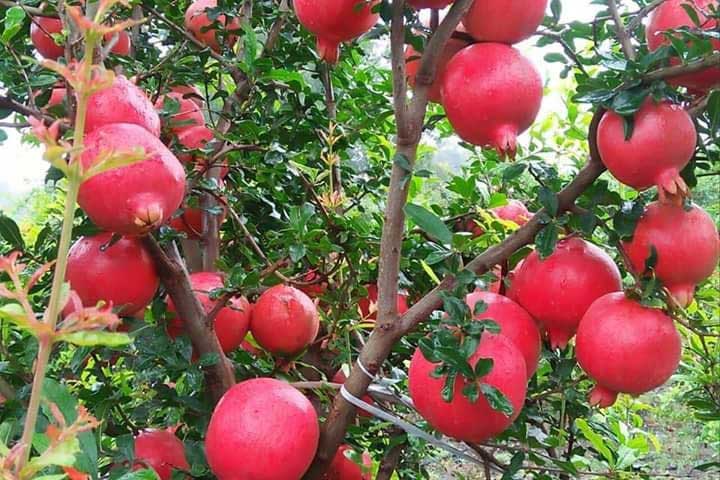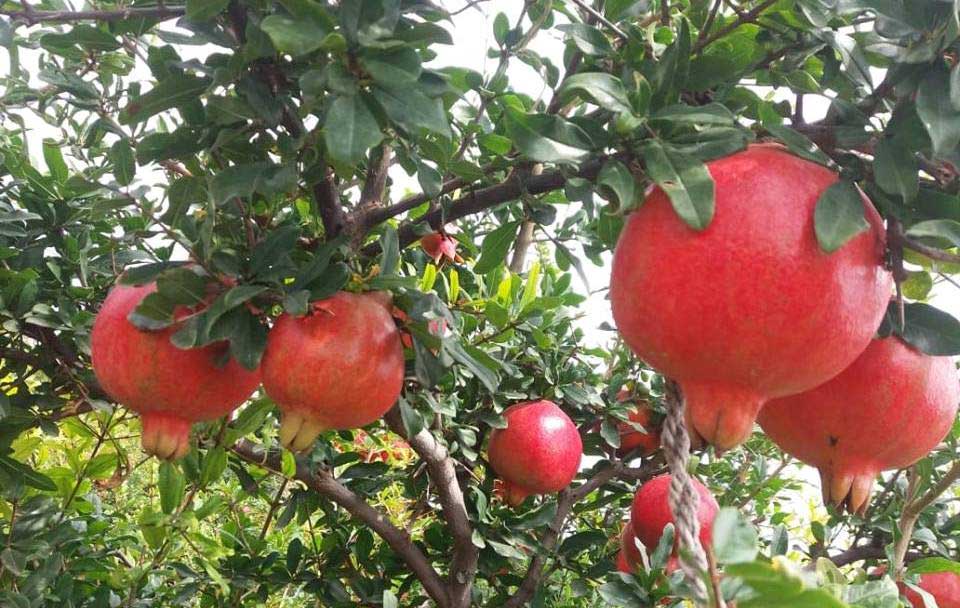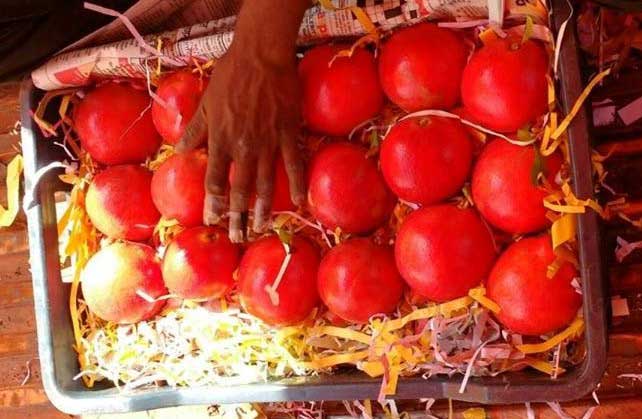- Pomegranate (Punica granatum L.) is an important fruit crop grown in India. It originated in Iran, and extensively Pomegranate farming is done in the Mediterranean countries like Spain, Morocco, Egypt, Iran, Afghanistan, and Baluchistan. It is cultivated to some extort in Myanmar, China, and USA.
India ranks first in pomegranate cultivation in the world. In India, major pomegranate producing states are Maharashtra, Karnataka, Gujarat, Andhra Pradesh, Madhya Pradesh, Tamil Nadu Rajasthan.
Maharashtra leads with 90 thousand ha areas with an annual production of 9.45 lakh Mt tones and 10.5 Mt/ha productivity. Maharashtra state accounts for 78 percent of India’s total area and 84 percent of its total production.
Pomegranate is one of the most favorite table fruits. The fresh fruits are used for table purposes. They can also prepare processed products like juice, syrup, squash, jelly, anar rub, juice concentrates, carbonated cold-drinks, and anar dana tablets, acids, etc.
Pomegranate fruit is nutritious, rich in minerals, vitamins, and proteins. The juice is useful for leprosy suffering patients.

Climate
Successful pomegranate cultivation is essentially dry and semi-arid weather, where cold winter and high dry summer quality enables fruit production. Pomegranate plants can tolerate frost to some extent and may be considered drought-tolerant.
The optimum temperature for fruit development is 35 -38 ° C.
The region with 500 m above from sea level is best suited for pomegranate cultivation.
Soil
Considering the soil requirement, it can be grown under different soil types, from low-fertile to high-fertile soil. However, in deep loamy, it gives an excellent yield. It can tolerate salinity and alkalinity in the soil to a certain extent.
Soil having a pH range between 6.5 – 7.5 is ideal for Pomegranate farming.
Propagation method
Pomegranate plants can be commercially propagated through hardwood cutting, air layering, and tissue culture.
Hardwood cutting propagation:
It easy method, but its success rate is lesser, so this method is not popular among farmers. For Cutting selected from a one-year-old tree of 9 to 12 inches (25 to 30 cm) long, 4-5 buds are better for higher rooting and survival.
Air-layering propagation:

It’s the most common practice by farmers for raising new plants. For the air layering method, select 2 to 3 years old plants and air-layered followed by IBA (1,500 to 2,500 ppm) treatment for better rooting.
From a single plant, around 150 to 200 rooted cuttings can be obtained.
The rainy season is best suited for layering. It takes around 30 days for roots. After 45 days, the layered plants should be detached from the mother plant.
Expert Pomegranate grower identifies detach time by the observing colour of roots when it starts to turn brown the layered cuttings are separated. Then these are grown in polybags and kept for hardening up to 90 days under a shade net or Greenhouse.
Tissue culture propagation:
Tissue culture is an advance and rapid technique of the multiplication of plants. By using this technique, you can obtain diseases free planting material within a short time span.
This plant is available in the Pomegranate plant nursery; buy this plant from a reliable source.
Commercial Pomegranate varieties

These are the commercial varieties that grow in India.
- Bhagwa
- Mridula
- Ganesh
- Jyothi,
- Jalore Seedless
- Kandhari
- Phule Arakta
- Phule Bhagwa Super
- Bhagwa Sindoor
Bhagwa is the most cultivated variety due to its high demand for domestic and export purposes.
Pit preparation and planting:
 Ninety-days old Pomegranate plants are ready for transplanting into the main field in pits.
Ninety-days old Pomegranate plants are ready for transplanting into the main field in pits.
Prepare a suitable size of the pit is 60 cm x 6o cm x 60.
The ideal planting distance followed by farmers is 10 to 12 ft (3 to 3.6 m) between plants and 13-15 ft (3.9 to 4.5 m) between rows.
During monsoon, pits are filled with farmyard manure (10 kg), single superphosphate (500 gm), neem-cake (1 kg).
The optimum time for pomegranate planting is in the rainy season (July-August) when sufficient soil moisture is available for plants’ optimum growth.
Fertilizer management in Pomegranate farming

pomegranate can be grown even in the less fertile soil. Still, the recommended dose of chemical fertilizers should be incorporated in the pit for better production and quality of fruits.
The dose of manures and fertilizers varies according to types of soil fertility, genotypes, region to region.
Chemical fertilizers for better growth and development should be given as per the following recommendations:
| Fertilizers | one year plant | Five years & above plant |
| FYM | 50-60 kg | 50-60 kg |
| Urea | 10-20 gm | 50-60 gm |
| SSP | 150-300 gm | 900-1200 gm |
| MOP | 90-120 gm | 150 -200 gm |
For Ambe Bahar fertilizers should be given in December, and for Mrig Bahar fruits, fertilizers should be given during May
Irrigation
Pomegranate is a drought-tolerant fruit crop, which can sustain underwater scarcity to some extent.
Regular irrigation is also essential to reduce fruit splitting, which is the major disorder of fruits.
During winter, irrigation should be applied at 10 to 12 days of interval, whereas during summer at 4 to 5 days.
Most of the farmers supplied water through drip irrigation, saving water, and convenient to apply fertilizers.
Generally, Ambe Bahar is suggested where an irrigation facility is available. Otherwise, Mrig Bahar is preferred.
Training and pruning in Pomegranate
It is a promising technique to control vegetative growth and maintain the shape and size of trees to enable proper light penetration in the center of the tree, ease in cultural operations, spraying, and fruit harvesting.
There are two methods of training system followed in pomegranate.
1) In the single-stemmed method –
In this method, only one main shoot is kept by removing other shoots of the Pomegranate plant.
2) Multi-stemmed method –
In the multi-stemmed method, the Pomegranate plant bush shape is maintained by keeping 3-4 shoots at the base.
This method is very popular and commercially adopted by Pomegranate farmers because, even after a shoot borer, one shoot may provide yield instead of the complete loss.
Plant-protection
Pests :
1) Pomegranate butterfly (or) Fruit borer. (Deudorix Isocrates)
It is a major pest that bore into the developing fruits, feeds inside, and makes fruit susceptible to fungal and bacterial infection.
Control
It can be controlled by bagging young fruits at the early stage with polyethylene bags, spray phosphamidon 0.03 %, or sevin @4 gm.
2) Caterpillar
It makes holes in the main trunk and forms networks of tunnels inside it. Feeding on bark during nights and fill it with excreta.
Control
It can be effectively managed by plugging the hole with cotton dipped in petrol or kerosene, chloroform, carbon disulfide, followed by covering it with mud.
Nowadays, the bagging of fruits is also practiced by the farmers. This helps up to a certain extent and also improves fruit quality.
Diseases
1) Bacterial leaf spot or oily spot (Xanthomonas axonopodis pv. punicae):
It is characterized by the formation of small-dark brown water-soaked spots on the leaf, twig, stem, and fruits. Cracking can be observed with the shining appearance at a severe stage of infection. It is most severe in the rainy season
Control
It can be measured to some extent by spraying of streptocycline at the rate of 0.5 g/ liter and mixing with copperoxychloride at the rate of 2 g/ liter on three consecutive days.
2) Fruit cracking or fruit splitting
it is one of the most severe disorders due to irregular irrigation, boron deficiency, and sudden fluctuation in nocturnal and diurnal temperatures; fruits are cracked, which is a common problem in pomegranate.
Control
Spraying of boron at the rate of 0.1% and GA3atthe rate of 250 ppm disease can be minimized to some extent.
Besides, maintaining proper soil moisture levels; selecting cracking tolerant variety are some preventive measures.
3) Sunburn
It is also a major problem if fruits are not harvested at the proper stage. A blackish round spot appears
on the upper surface of fruits. It reduces the cosmetic appeal of fruits.
Control
Bagging of fruits maintains colour and attack of fruit flies.
Harvesting

Pomegranate harvesting is starting after 150 to 180 days from flowering to fruit maturity. But it depends on genotype, climatic condition, and growing region.
Harvesting of fruits should be done at the optimum maturity stage because early harvesting results from the dull, immature, and improper ripening of fruits. In contrast, late harvesting leads to more prone to the attack of disorders. However, Pomegranate is a non-climacteric fruit that should be harvested after at proper ripening stage.
There are several harvest signs used to assess the maturity and harvesting of pomegranate fruits. Dark rose pink
colour should develop on the surface and dark pink aril mostly preferred by the consumers.
The calyx at the bottom of Pomegranate fruits gets turn inward side is also a maturity index. Aril should be turned in deep red or pink. Fruits of pomegranate should not be over-ripened.
Fruits should be harvested with secateurs or clippers’ help because manual twisting may cause damaged fruits in clusters.
Yield of Pomegranate
A healthy Pomegranate tree can produce up to 12 to 15 kg/ plant yield during the first year. From the second year onwards, the yield per plant is around 15 to 20 kg.
Postharvest handling
It follows the given steps.
Cleaning and washing:
After harvesting, fruits should be sorted out because diseased and cracked fruits should be removed, and healthy fruits are selected for further treatment.
After sorting, fruits should be washed with solution sodium hypochlorite at the rate of 100ppm in water. This treatment will be helpful to reduce microbial contamination and to maintain a longer shelf-life.
Pre-cooling:
It is an essential operation before storage of fruits, so It helps to remove vital heat and field heat of produce
which results in shelf-life enhancement of fruits.
For pomegranate fruits, the forced air cooling system is used for precooling. Hence it should be maintained around 5ºC with 90% relative humidity.
Grading of fruits:
Graded fruits attract and appeal to the consumers, which helps get a higher price from domestic and international markets.
Their size and weight generally grade pomegranate fruits. However, grading standards are varying from country to country.
However, grade specifications as per National Horticulture Board for the export purpose are as follows.
| Grade | Fruit weight |
| Supersize | 750 gm |
| King size | 500-700 gm |
| Queen size | 400-500 gm |
| Prince size | 300-400 gm |
Pomegranate Packaging
Pomegranate fruits are packed in wooden boxes, plastic crates for domestic and local markets.
For the international market, mainly corrugated fibreboard boxes are used, and the capacity of the box should be
4 kg or 5 kg.
According to AGMARK specifications dimension of the 4 kg capacity box is 375×275×100 mm3 and for the 5 kg box is 480×300×100 mm3.
Temperature is the most crucial factor for pomegranate shelf-life because pomegranate fruits are perishable in nature, so an optimum temperature is required for long-term storage.
The very low temperature may induce chilling injury in fruits, so an ideal temperature for the storage of fresh pomegranate fruit is 6° to 7°C and 90 to 95% Relative Humidity. At this temperature, Pomegranate fruits can store up to 3 months.
Marketing
Marketing is done with an agent or broker’s help, whereas own marketing is possible only at a low production level.
Pomegranate fruits can make a sale at the wholesale rate of 60 to 80/kg fruits in domestic markets, whereas in the distance market, it gets a higher price of 90 to150/kg fruits.





Thank you so much for the article on pomegranate cultivation. Simple and informative.
You’re welcome, Poongodi.
Very useful and informative article sir. Do you provide training and saplings of pomegranate plants. I am interested for pomegranate plantation in west bengal
Hello Rahul,
Thank you, please contact us at 8788462787
It is very useful information for I am interested in cultivation pomegranate.
Thanks, Pandurang. I appreciate that
Hi Amar
Nice blog! Can we connect to understand suitable crop for my field and ect
Thank you
It is very useful information for i am interested in cultivation pomegranate
Thank you
Than for complete guidance.
Well-done.
keep posting further crops also.
Thank you sir.
Very very useful information . Thank you
Thank you so much, sir
Thank you so much, sir
thank for nice article Mr.Amar Sawat
Thank you sir
Hi Amar
I am based in Kenya. Could I have your email address to discuss the growing of pomegranates in coastal region
Hardeep
Hello Hardeep,
please contact us on [email protected]
It is very good and use full information, good job
Thank you sir
It was short and informative , Thanks Amar.
Can I have your number pls.
Thank Venkat, please contact 8788462787
Hi Amar, very useful article. Thank You
Thank you
Thank you Mr Amar, the article was very helpful and informative, keep the good work up and good luck bro..
Thank you Messberk.
Very nice information sir.
Thank you, sir
Hello Mr. Amar ….first of all thanks a lot for the information you have posted here,
Actually sir i am personally thinking to cultivate pomegranate in my area can you pls guide me
+91-9267717777
[email protected]
Thanks
Hello Suresh,
please contact 8788462787
Thanks Amar
Thank you sir. You are the best
Thank you Abhinandan
Thank you for sharing your knowledge to us….
Thanks pavan
Hi Amar
really nice article.!! could you please share your email address – would like to get in touch
Hello Rohit
Thank you so much, please contact at 8788462787 or [email protected]
Many thanks for this info. Really helpful. Thanks Amar.
Thank you
Good sir Jim…very informative
Thank you sir
Can Pomegranate grow in partial shade
Hello Jawahar,
Pomegranate required good sunlight.
Very precise and informative. Selfless and professional information shared!
I need to contact you.
Well done!
Please contact us at [email protected]
Really Crisp and complete information. Well done.
Useful Article
Thank you very much for the information on pomegranate crop.
Your article is very usefull
Thank you
well come